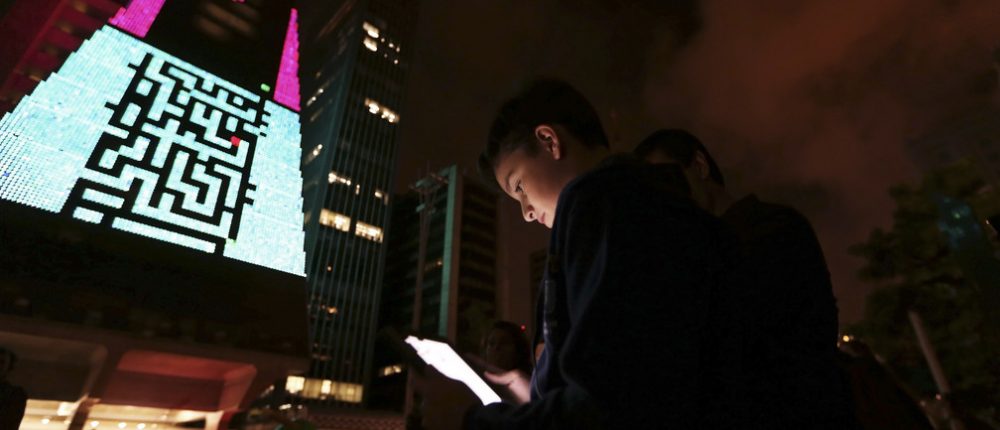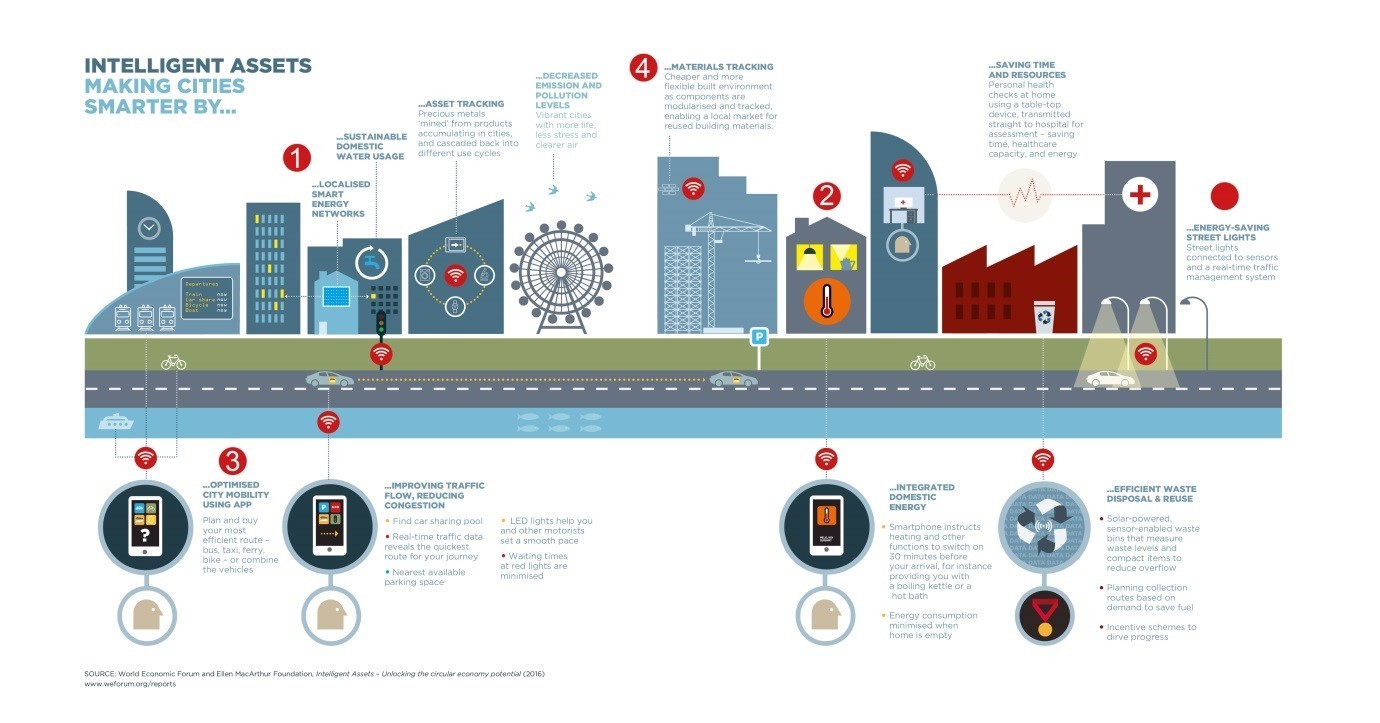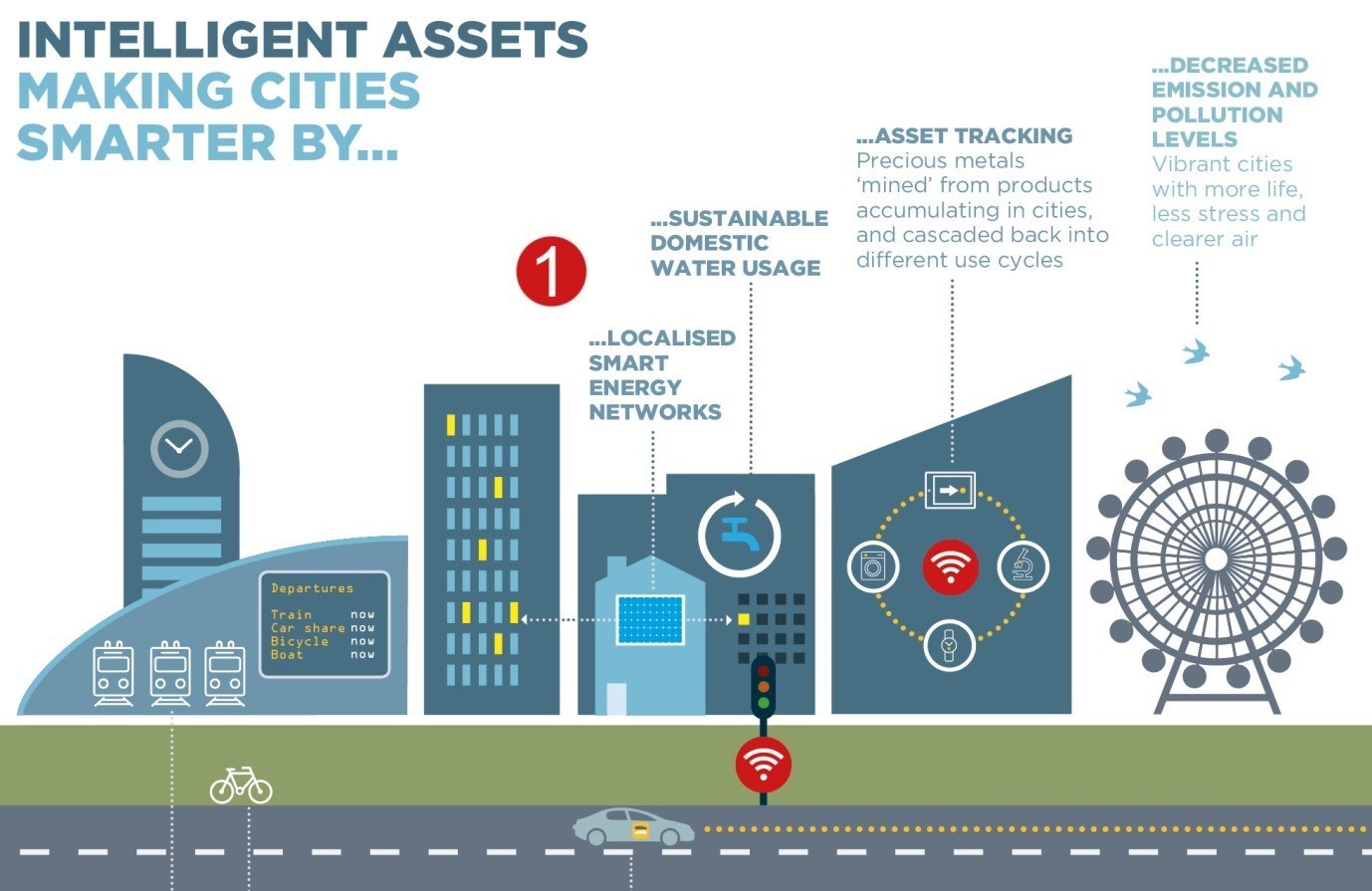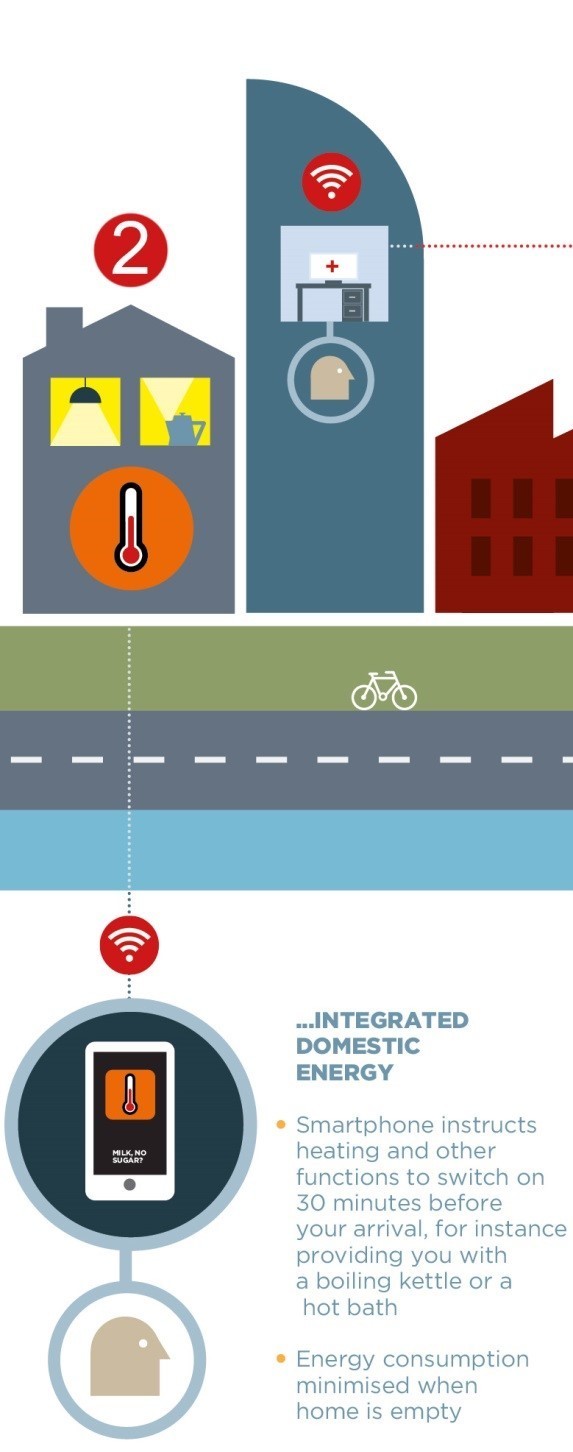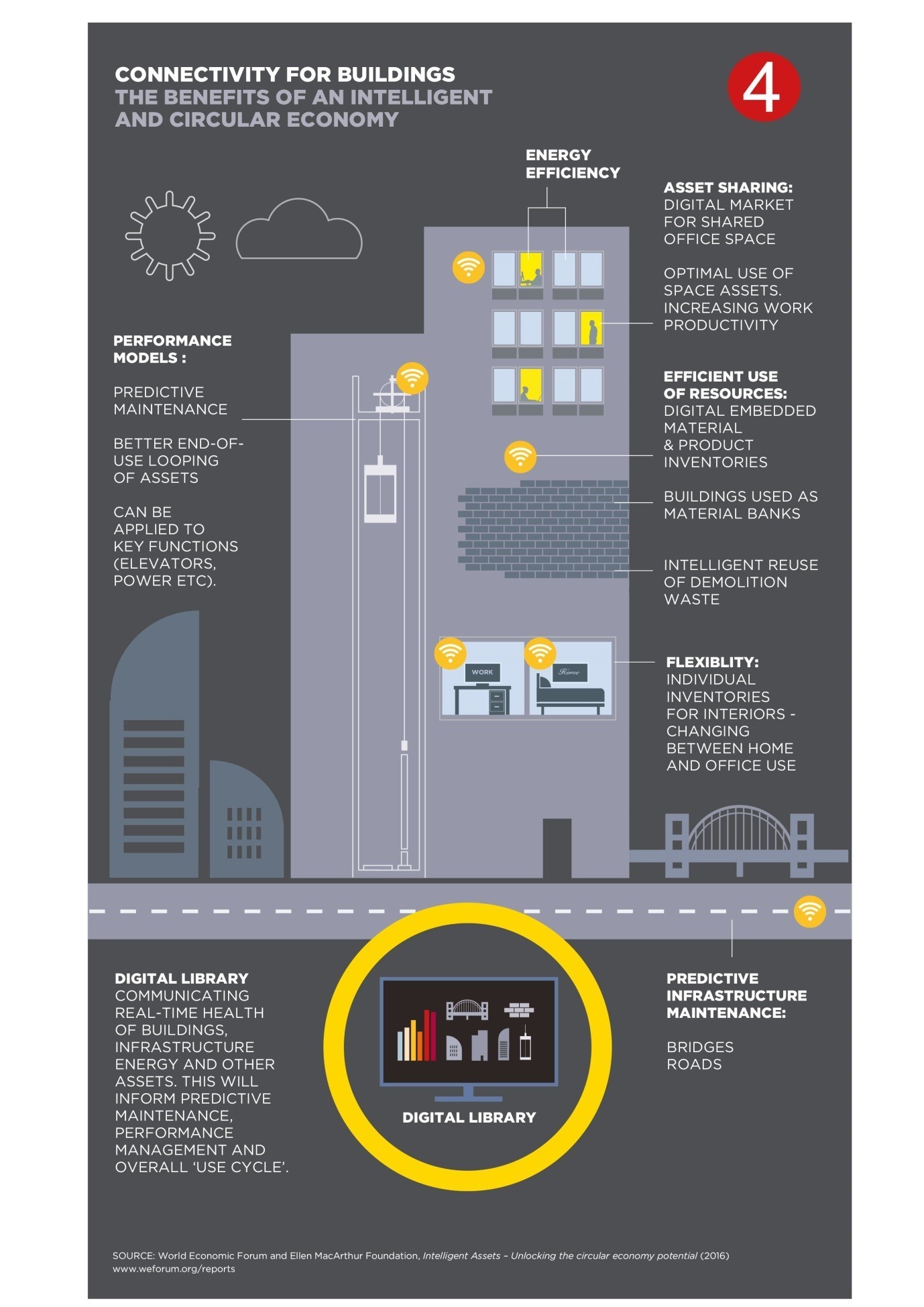Four ways smart cities will make our lives better
Contents |
[edit] Introduction
As demonstrated in a new report, the rapid and pervasive development of digital technologies, along with an understanding of circular economy principles, will drastically change life for the average urban citizen much sooner than we think.
The circular economy is a concept by which materials and products are kept at their highest possible value at all times. Finite materials are not thrown into landfills and valuable assets from cars and office space to spare rooms and sporting equipment are not left idle.
The rise of the Internet of Things (IoT) will help this to become a reality. Sensors and smart phones will be able to track materials and assets, letting people know when they are not being used, about to break, or where they are. This will unlock huge amounts of spare capacity in the system, creating new business models that will drastically change the way the city functions. The digital circular city would not only save resources but would change the citizen’s experience for the better.
[edit] What would life in the connected city look like?
[edit] Smart energy networks
Your power supply could look very different. Current grid systems are relatively inefficient, long distance energy transmission from centralised power plants can lead to losses of up to 30%.
In the future, the IoT could lead to a distributed energy network. Households, factories and public buildings will generate their own electricity from renewable sources, using the excess space in walls, roofs and even windows for solar and wind generation. These connected devices will then store any excess energy in various batteries, including the ones in cars or homes – these distributed energy systems could reduce electricity bills by up to 25%.
All energy-generating entities will be connected through a grid, allowing them not only to be self-sufficient, but also to contribute to the supply stability of the whole region. Smart sensors will monitor the condition of these capital intensive assets, so that they can be easily maintained, anticipating failures before they happen and making the electricity system even more cost efficient.
[edit]
On walking out the door of your home, smart thermostats will trigger the heating in the apartment to turn down to a minimum, saving energy (and lowering bills). Citizens could make even better use of their assets by converting an extra room into a secure office, rentable on a city-wide sharing platform.
Should someone want to rent it on a given day, the heating will quickly power up in time for the temporary resident to feel comfortable and welcome. Demand is likely to be strong – the connected city will have more remote workers and contractors who would appreciate the quiet space.
[edit] Optimised mobility
As you leave home, getting to work would be a far less stressful experience. Today the average city dweller spends 15% of driving time in congestion and 20% looking for a parking space. In an IoT enabled city, real time traffic data streams, car sharing schemes and mobile parking apps will smooth the experience decreasing road traffic, emissions and time wasted.
Transport apps will use real time traffic and public transport data to offer citizens the quickest route to their destination by bike, train, self-driving car or bus. If walking turns out to be the quickest route then smart street lamps would increase their luminosity as you draw closer and decrease as you walk away, saving huge amounts of energy without compromising on public security.
[edit]
As you walk into your office complex you are likely to have your desk assigned to you based on who you’re meeting with and your personal preferences. When you leave work at the end of the day the office space around you could be converted into a social/networking event space. Developers will have planned out the space from its inception so that it is flexible enough to accommodate a variety of activities, not just desk work, maximising the value of urban space.
Flexibility would not be the only design consideration in a circular city. Whole buildings would be designed as ‘resource banks’. Tracking technologies and material passports could easily record exactly what materials were used to construct the building. All the assets in your office building could be effectively reused when the building is decommissioned or refurbished.
Read Intelligent Assets: Unlocking the circular economy potential.
This report was written under the umbrella of Project MainStream, a multi-industry, global initiative launched in 2014 by the World Economic Forum and the Ellen MacArthur Foundation, with McKinsey & Company as knowledge partner, and led by the Chief Executive Officers of nine global companies: Averda, BT, Desso, Royal DSM, Ecolab, Indorama Ventures, Philips, Suez and Veolia.
Written by
- James Pennington, Project Specialist, Circular Economy at the World Economic Forum. Ashima Sukhdev, Project Manager, Ellen MacArthur Foundation, Insights & Analysis team.
This article was also published on the Future of Construction Knowledge Sharing Platform and the WEF Agenda Blog.
--Future of Construction 15:13, 16 Jun 2017 (BST)
[edit] Find out more
[edit] Related articles on Designing Buildings Wiki
- Can we build cities that anticipate the future?
- Designing smart cities.
- Engineering Smart Cities.
- European connected and smart home market.
- Global smart cities market.
- Internet of things.
- Measuring the success of smart cities.
- Smart cities need to find some smarter answers.
- The innovations making our cities smarter and greener.
- The Living City: Rethinking our role in the Digital Age.
- The problems with smart buildings.
- Virtual reality and big data disrupting digital construction.
- What will a fourth generation city look like?
Featured articles and news
Government consultations for the summer of 2025
A year of Labour, past and present consultations on the environment, the built environment, training and tax.
CMA competitiveness probe of major housing developers
100 million affordable housing contributions committed with further consultation published.
Homes England supports Greencore Homes
42 new build affordable sustainable homes in Oxfordshire.
Zero carbon social housing: unlocking brownfield potential
Seven ZEDpod strategies for brownfield housing success.
CIOB report; a blueprint for SDGs and the built environment
Pairing the Sustainable Development Goals with projects.
Types, tests, standards and fires relating to external cladding
Brief descriptions with an extensive list of fires for review.
Latest Build UK Building Safety Regime explainer published
Key elements in one short, now updated document.
UKGBC launch the UK Climate Resilience Roadmap
First guidance of its kind on direct climate impacts for the built environment and how it can adapt.
CLC Health, Safety and Wellbeing Strategy 2025
Launched by the Minister for Industry to look at fatalities on site, improving mental health and other issues.
One of the most impressive Victorian architects. Book review.
Common Assessment Standard now with building safety
New CAS update now includes mandatory building safety questions.
RTPI leader to become new CIOB Chief Executive Officer
Dr Victoria Hills MRTPI, FICE to take over after Caroline Gumble’s departure.
Social and affordable housing, a long term plan for delivery
The “Delivering a Decade of Renewal for Social and Affordable Housing” strategy sets out future path.
A change to adoptive architecture
Effects of global weather warming on architectural detailing, material choice and human interaction.
The proposed publicly owned and backed subsidiary of Homes England, to facilitate new homes.
How big is the problem and what can we do to mitigate the effects?
Overheating guidance and tools for building designers
A number of cool guides to help with the heat.
The UK's Modern Industrial Strategy: A 10 year plan
Previous consultation criticism, current key elements and general support with some persisting reservations.
Building Safety Regulator reforms
New roles, new staff and a new fast track service pave the way for a single construction regulator.







